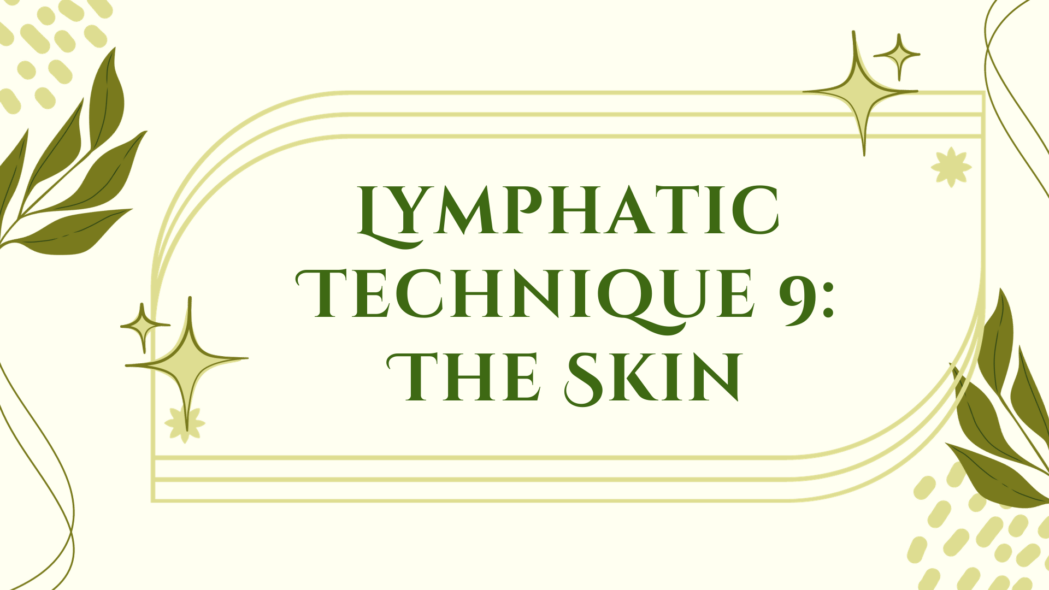
- This event has passed.
Lymphatic Technique 9: The Skin
February 10, 2024 @ 9:00 am – 6:00 pm CST

February 10 9am-6pm Central
Free and Open to All
Online Via Zoom
Lymphatic 9: Skin Regiments
This class will be utilizing skin regiments to address the follow skin related areas:
Protection:
The skin acts as a barrier that protects the body from external factors such as bacteria, viruses, UV radiation, and physical injury.
Regulation of Temperature:
It helps regulate body temperature by sweating (cooling) and constricting blood vessels (warming).
Sensation:
Skin contains nerve endings that allow us to sense touch, pressure, temperature, and pain.
Excretion:
Sweat glands in the skin help eliminate waste products and regulate electrolyte balance.
Absorption:
Some substances, like medications and vitamins, can be absorbed through the skin.
Immunity:
The skin contains immune cells that help defend against infections.
Synthesis of Vitamin D:
When exposed to sunlight, the skin synthesizes vitamin D, which is important for bone health.
Blood Reservoir:
Skin can act as a reservoir for blood, helping to regulate blood flow to vital organs.
Wound Healing:
The skin can repair itself through a process called wound healing, which involves inflammation, tissue repair, and remodeling.
Hair and Nail Growth:
Skin is also responsible for the growth of hair and nails.
These functions and processes collectively help maintain the body’s overall health and well-being.
Lymphatic Drainage:
The skin is rich in lymphatic vessels and capillaries that help transport lymphatic fluid, a clear fluid that carries waste products and immune cells, away from the tissues. This drainage system helps maintain tissue fluid balance and removes waste products from the skin.
Immune Function:
The skin contains immune cells, such as Langerhans cells and macrophages, that are part of the body’s defense against infections. These cells are located in the epidermis and dermis layers of the skin and help recognize and combat pathogens that may enter through cuts, scrapes, or other openings in the skin.
Defense Against Infections:
The skin acts as a physical barrier to prevent pathogens from entering the body. If the skin is compromised (e.g., by a cut or injury), the lymphatic system in the skin helps initiate an immune response to defend against potential infections.
Epidermis:
The outermost layer of the skin is called the epidermis. It is primarily composed of layers of specialized cells, including keratinocytes, which produce the protein keratin that helps form a protective barrier. The epidermis also contains melanocytes, responsible for skin pigmentation, and Langerhans cells, part of the immune system. The topmost layer of the epidermis, the stratum corneum, is comprised of dead skin cells that provide protection and are constantly shedding and renewing.
Dermis:
Beneath the epidermis lies the dermis. It is a thicker layer that contains various structures, including blood vessels, sweat glands, hair follicles, and nerve endings. The dermis provides support and nourishment to the epidermis and is responsible for regulating temperature, sensation, and the production of sweat and sebum.
Subcutaneous Tissue (Hypodermis):
The subcutaneous tissue, or hypodermis, is the deepest layer of the skin. It primarily consists of fat cells (adipocytes) and connective tissue. The hypodermis serves as insulation, cushioning, and energy storage. It also connects the skin to underlying muscles and bones.
Here are some associations and mechanics of how the skin can impact mood:
Sensory Perception:
The skin is rich in sensory receptors that transmit information to the brain, allowing us to perceive touch, temperature, and pain. Pleasant sensations on the skin, such as a gentle massage or warm bath, can stimulate the release of endorphins, which are natural mood-enhancing chemicals. This can lead to feelings of relaxation and improved mood.
Temperature Regulation:
The skin helps regulate body temperature. Being too hot or too cold can be uncomfortable and impact mood negatively. Extreme heat may lead to irritability, while cold temperatures can trigger stress responses.
Touch and Affection:
Touch is a powerful way to communicate emotions and establish bonds with others. Hugging, cuddling, or holding hands can release oxytocin, often referred to as the “love hormone,” which promotes feelings of trust, attachment, and well-being.
Skin Conditions:
Skin conditions like eczema, psoriasis, or acne can negatively affect self-esteem and body image. Dealing with visible skin issues may lead to feelings of embarrassment, self-consciousness, or even depression in some cases.
Skin and Social Interactions:
The condition and appearance of the skin can influence how individuals feel in social situations. Confidence in one’s skin can impact self-esteem and social interactions, affecting overall mood.
Hormonal Influence:
Hormonal changes, including those related to the menstrual cycle, pregnancy, or menopause, can affect the skin’s condition and contribute to mood swings and emotional changes.
Skin-Care Rituals:
Engaging in self-care routines like skincare rituals can have a positive impact on mood. For some, the act of pampering the skin with soothing products can create a sense of relaxation and well-being.
Psychological Factors:
Perception of one’s own skin, body image, and self-confidence play a crucial role in mood. Negative self-perception related to the skin can lead to anxiety and depressive symptoms.
Skin Disorders and Mental Health:
Skin disorders like dermatillomania (skin picking) or trichotillomania (hair pulling) can be associated with underlying mental health issues and impact mood negatively.
Choose an oil from each line
Line 1
Some form of massage oil, lotion, or alcohol for topical applications
Line 2
Single Oils: Helichrysum, Chamomile, Yarrow, Milfoil
Line 3
Single Oils: Coffee, Parsley, Lovage, Kunzea, Cypress, Elemi, Palo Santo
Line 4
Single Oils: Myrrh, Spikenard, Cypress
Line 5
Single Oils: Terebinth, Pine, Myrtle
Line 6
Single Oils: Hyssop, Rosemary, Sage
Or
Kit for sale: $95 ($140 value)
2oz unscented BT
2oz Sesame Oil
Helichrysum 5ml
Terebinth 5ml
Spikenard 5ml
Parsley 5ml
Rosemary 5ml
Coffee 5ml
info@plantpranaoils.com



